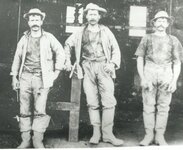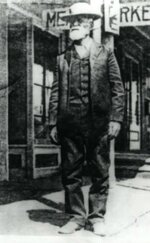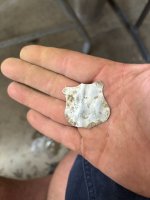K
Kentucky Kache
Guest
The Gold Road Mine
José's Lucky Strike Pays Off
José's Lucky Strike Pays Off
Back in Kingman with sacks full of ore samples, José found his rich vein in Gold Road Gulch carried 40 ounces of gold to the ton; $800 a ton, when it cost $8 a ton to mine and mill the ore. At 64, prospector José Jerez became a rich man. But now he had to move fast. Word of a rich strike travels faster than bad news, and claimjumpers would soon be racing 30 miles across the desert to the fabulous unclaimed wealth there for the taking at Gold Road.
As soon as he had the assay results, Jose told his partner Henry Lovin the good news, and they immediately rode out to stake their claims on the lode. Each partner was entitled to one claim, 1500 feet along the vein and 300 feet on each side. On May 14th, 1900, they posted location notices for the "Line Road" and "Gold Road" claims.
Between the two, Jerez and Lovin had 3,000 feet along the vein; but since the vein's almost two miles long (almost 12,000 feet), a few of their friends were able to get in on it as well. The entire vein was "claimed up" in no time.
The partners, using hand tools, dug a couple of ten-foot holes on their claims as the required location work. The two holes made them $1500 richer, and exposed a vein 15 feet wide carrying $20 to the ton. Now they had to decide whether to be gold miners, or sell their claims.
The fact is, hard rock mining takes a major investment in equipment and facilities; it's usually a very high-stakes gamble calling for a large pool of investors to absorb the potential losses, as well as the gains.
The two partners sold their claims for $50,000 and split it right down the middle. And wouldn't you know it, the ore disappeared in the next foot the new owner dug down. He kept digging, though, and hit a large body of rich ore in another 100 feet. He was able to sell the property for $250,000.
These old-time hard rock gold miners worked by the light of the candles they're holding
Photo courtesy of the Mohave County Historical Society
Photo courtesy of the Mohave County Historical Society
Serious development began in 1902. Compressed air drills replaced the hand steels and hammers of Gold Road's first explorers. A mill and cyanide plant were built to extract the gold from its native ore. By 1907, about 100,000 tons of ore had been processed, producing over $2,000,000 in gold.
All this time, former prospector José Jerez had been living the high life off the proceeds of his lucky strike. $25,000 back then was worth some $500,000 today, and José went through it in true Western fashion, going on a spree until his money ran out.
José Jerez on the streets of Kingman.
Photo courtesy of the Mohave County Historical Society
Photo courtesy of the Mohave County Historical Society
In its August 25th 1900 edition, the Mohave County Miner took note of José's doin's:
"José Jeris, discoverer of the Bryan mines, has gone to Los Angeles, believing that Kingman was too small and the attractions too few for a man of his purse. If José gets acquainted with Poker Davis, the care of his purse will not bother him in future."
José was soon back in Kingman, but good living and bad business deals steadily drained his wealth. By 1906, José was living at the town of Gold Road, 70 years old, debilitated and penniless. His life was behind him, but he could look back with some satisfaction; he'd lived long enough to make his big score and spend every cent of it. In the end, what 70 years of hard frontier living couldn't do, what $25,000 worth of cheap whiskey couldn't do, José did to himself. "Rough on Rats" poison was rough on José. He was buried in the Gold Road cemetery.
But to this day, some still wonder how a 64-year-old man could go through that much money in only six years. Could he have buried his remaining riches around Gold Road in a fit of drunken paranoia? Was he really down and out, or did "delirium tremens" make him think he had rats in his stomach? Is there a treasure trove of José's hoarded gold hidden somewhere in this rugged desert range? Maybe someday we'll find out.
1907 brought the first of many breaks in Gold Road's production history. Plans for a new electric generating plant in Kingman made the cost of freighting fuel to the mine site seem like a foolish expense. The gold wasn't going anywhere, so the mine closed down until the new powerhouse was built in 1909. When it re-opened, the mine contracted for 600 hp of the generator's 2400 hp capacity, and its energy costs were cut by about half.
The mine was worked on and off for the next 35 years. It's the nature of the business. When operating expenses go up, or gold prices go down, the miners are laid off. The gold isn't going anywhere.
In 1942 the same government order that shut the Oatman mines closed Gold Road. The town the mine supported was abandoned, and its post office was closed. In 1949, every building left was carried away or destroyed to reduce the property taxes. One of the Old West's greatest success stories seemed to evaporate into the hot dry desert air.
But the gold was still there, and it wasn't going anywhere.
http://www.gazette9.com/rt66/grmine.htm






